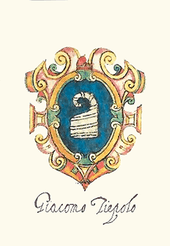Jacopo Tiepolo

_-_Foto_G._Dall'Orto%2C_10-Aug-2007.jpg)
Jacopo or Giacomo Tiepolo (born at Venice and died 19 July 1249 at Venice) was Doge of Venice from 6 March 1229 to 2 May 1249. He had previously served as the first Venetian duke of Crete, and two terms as podestà in Constantinople (1218-1220 and 1224-1227). During his first term, following the capture and mysterious end of Peter of Courtenay, Tiepolo acted as de facto ruler of the Latin Empire, negotiating treaties on behalf of the Empire with Egypt and the Seljuk Turks.[1]
At the election for doge, Tiepolo and his rival Marino Dandolo were tied at 20 votes each, and Tiepolo was selected by drawing lots. This is thought to have sparked the feud between the Dandolo, who were an old aristocratic family, and the Tiepolo, who were seen as nouveau-riches.[2] Prior to ascending the ducal throne, Tiepolo also had to sign a traditional promissione, which seriously limited his powers.[3]
Despite Emperor Frederick II's cordial visit in Venice in 1232, the relations between the emperor and the Republic deteriorated and, in 1239, Venice joined the Lombard League and fought against Ezzelino III da Romano, a powerful ally of Frederick. In the subsequent fights the Doge's son, Pietro Tiepolo, was captured at the battle of Cortenuova 1237 and died in prison in South Italy.
Jacopo Tiepolo's reign brought other important events: In 1242 the Doge proclaimed Statuto, the codification of the Venetian civil law - work begun by Doge Enrico Dandolo. In the 1240s, two great mendicant orders: the Dominicans and the Franciscans, were granted land in the city and later built on it the two biggest churches in Venice, Santi Giovanni e Paolo, (called San Zanipolo) and Basilica di Santa Maria Gloriosa dei Frari.
In 1249 Tiepolo abdicated, retired to his own house and died after a few months. He was buried in the church of San Zanipolo. His wives were Maria Storlato and Valdrada of Sicily.
Jacopo Tiepolo was the father of Lorenzo Tiepolo who served as doge from 1268 to 1275 and the aforementioned Pietro Tiepolo, podestà of Padua.
References
- ↑ Donald M. Nicol, Byzantium and Venice: A study in diplomatic and cultural relations (Cambridge: University Press, 1988), pp. 162-164
- ↑ John Jeffries Martin and Dennis Romano, Venice Reconsidered: The History and Civilization of an Italian City-state, p. 77-81
- ↑ John Julius NorwichA History of Venice (London: Penguin Books), p. 151
| Political offices | ||
|---|---|---|
| Preceded by Pietro Ziani |
Doge of Venice 1229 – 1249 |
Succeeded by Marino Morosini |